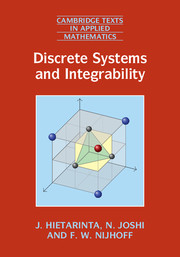Book contents
- Frontmatter
- Dedication
- Contents
- Preface
- 1 Introduction to difference equations
- 2 Discrete equations from transformations of continuous equations
- 3 Integrability of P∆Es
- 4 Interlude: Lattice equations and numerical algorithms
- 5 Continuum limits of lattice P∆E
- 6 One-dimensional lattices and maps
- 7 Identifying integrable difference equations
- 8 Hirota's bilinear method
- 9 Multi-soliton solutions and the Cauchy matrix scheme
- 10 Similarity reductions of integrable P∆Es
- 11 Discrete Painlevé equations
- 12 Lagrangian multiform theory
- Appendix A Elementary difference calculus and difference equations
- Appendix B Theta functions and elliptic functions
- Appendix C The continuous Painlevé equations and the Garnier system
- Appendix D Some determinantal identities
- References
- Index
6 - One-dimensional lattices and maps
Published online by Cambridge University Press: 05 September 2016
- Frontmatter
- Dedication
- Contents
- Preface
- 1 Introduction to difference equations
- 2 Discrete equations from transformations of continuous equations
- 3 Integrability of P∆Es
- 4 Interlude: Lattice equations and numerical algorithms
- 5 Continuum limits of lattice P∆E
- 6 One-dimensional lattices and maps
- 7 Identifying integrable difference equations
- 8 Hirota's bilinear method
- 9 Multi-soliton solutions and the Cauchy matrix scheme
- 10 Similarity reductions of integrable P∆Es
- 11 Discrete Painlevé equations
- 12 Lagrangian multiform theory
- Appendix A Elementary difference calculus and difference equations
- Appendix B Theta functions and elliptic functions
- Appendix C The continuous Painlevé equations and the Garnier system
- Appendix D Some determinantal identities
- References
- Index
Summary
In this chapter we discuss difference equations with one (discrete) independent variable. Their continuous analogues describe, for example, the motion of point particles. In that context the Hamiltonian formulation and the Liouville–Arnold integrability play a central role. In the discrete-time case the situation is more complicated, because we do not have the analogue of the chain rule of time derivative, and furthermore the motion is given by finite time steps rather than by a continuous time flow.
The difference between continuous and discrete systems is underscored by the observation that whereas a one-degree-of-freedom (autonomous continuous time) Hamiltonian system always has one conserved quantity, namely the Hamiltonian (= energy) itself, it turns out that generically one-degree-of-freedom discrete-time systems do not posses a conserved quantity. Surprisingly, there does exist a rather large family of (autonomous) one-degree-of-freedom maps called Quispel–Roberts–Thompson (QRT) maps, which possess a conserved quantity or invariant. They are examples of what we will call integrable maps. There are also extensions to more than one-degree-of-freedom maps (variously called higher-dimensional or multicomponent maps) and to nonautonomous maps (i.e. maps depending explicitly to the discrete independent variable, usually denoted by n). A classification of integrable nonautonomous maps corresponding to Painlevé equations is discussed in Chapter 11.
Integrable systems are rare and it is difficult to find such systems. One efficient way of deriving integrable maps is to start with a 2D integrable lattice equation (such as the ones discussed in Chapter 3) and apply a dimensional reduction to it in order to derive a 1D lattice equation (i.e. an equation in one discrete independent variable), which we interpret as a dynamical map. We will show that this can be done so that the integrability properties of the original 2D lattice, such as the existence of a Lax pair, carry over to the map, and can be used to derive their invariants.
Integrability of maps
There are several properties associated with integrability of maps, for example, the existence of a sufficient number of conserved quantities, symmetries, Lax pair and the behavior around singularities. In this section we will discuss the notion of Liouville integrability and the structures associated with it.
- Type
- Chapter
- Information
- Discrete Systems and Integrability , pp. 159 - 196Publisher: Cambridge University PressPrint publication year: 2016

